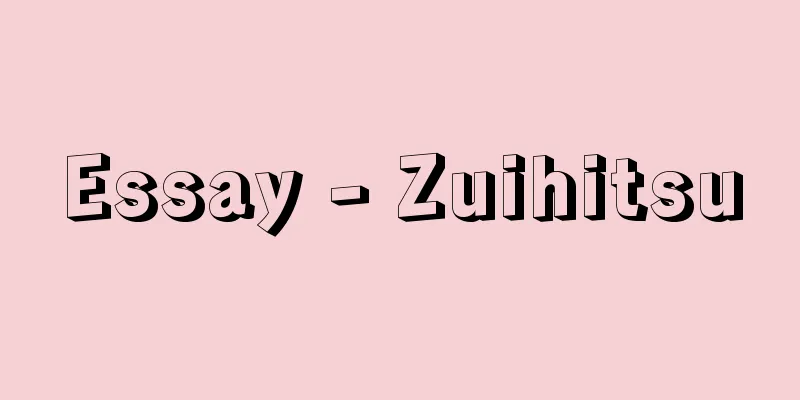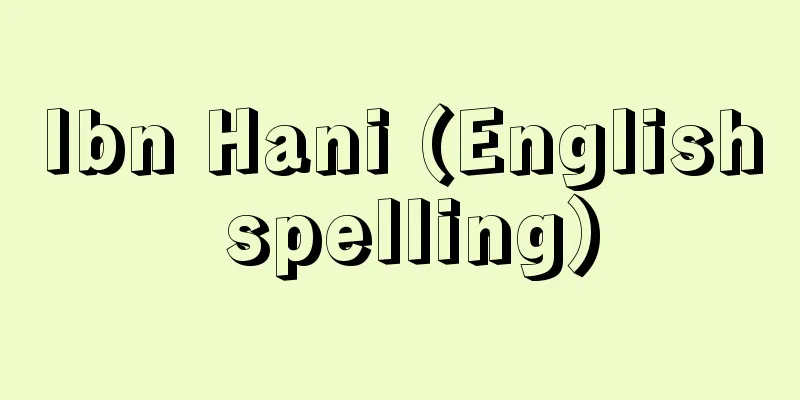Essay - Zuihitsu

|
The first work called an essay was Ichijo Kanera's Tosai Essays in the Muromachi period, but this work was a collection of factual accounts and legends quoted and classified from previous books, and is different from the essays that are generally referred to. Essays are prose works written freely without any restrictions on form and cover a wide range of topics, such as observations, criticism, speculations, and research on nature, human affairs, history, and society, and they also serve as a concise expression of the writer's personality, qualities, and talent. Essays became popular as a literary genre among scholars of Chinese and Japanese classics in the early modern period, but in modern times, especially after the Taisho period, they came to be recognized as a literary form corresponding to the essay that developed in Western Europe, and their lineage can now be traced in literary history. [Ken Akiyama] JapanFrom the Heian Period to the Middle AgesThe Pillow Book, written by Sei Shonagon in the Heian period, is the first work worthy of being called an essay. The various aspects of nature and human affairs, captured with a sharp and delicate sensibility, represent the height of the aesthetic sense of the imperial aristocracy and have continued to have a normative significance for later generations. Kenko's Tsurezuregusa, written during the Nanboku-cho period, can be said to have been inspired by The Pillow Book. Kamo no Chomei's Hojoki, written in the Kamakura period, is also said to be an excellent piece of essay literature, but should this be considered a book that expresses the author's thoughts, written with a clear concept? In addition to the Hojoki and Tsurezuregusa, there were many essay-like works in the Middle Ages, probably because this free form was chosen as a way of expressing thoughts during a turning point when the traditional values that had been held since the imperial court were being relativized. In addition to "Tales of the Four Seasons," said to have been written by Kamo no Chomei, and Ichijo Kaneyoshi's "Sayo no Nezame" and "Shodancho," numerous Buddhist teachings would also be included in the scope of essays. [Ken Akiyama] Early modern periodIn the early modern period, due to the shogunate's civil government policies and the increasing desire for knowledge among the common people, the cultures of Kamigata and Edo flourished after an initial period of enlightenment. The popularity of essays was a notable expression of this trend of the times and can be said to be a valuable testimony to culture. These include works in the pseudo-classical style, such as Saito Tokugen's (1559-1647) Mōmojō no Sōshi and Joraishi's Kasho-ki, which imitate the style of The Pillow Book and Tsurezuregusa; Nakae Toju's Okina Mondō and Kagami-gusa; Suzuki Shōzō's The Language of Inca Fruits; and Yamaoka Genrin's Tagami no Ue, which are didactic; Arai Hakuseki's Oritaku Shiba no Ki; and Kyokutei Bakin's Boku no Ue. Autobiographical works such as "Iwadememono-ki" (The Records of Iwadememono), philosophical works such as "Kagetsu-soshi" by Matsudaira Sadanobu, "Dokugo" by Dazai Shundai, and "Gyokukatsu-ma" by Motoori Norinaga, "Kawa-sha" (The River Shrine) and "Enju-an Zakki" by Keichu, "Nenzan-kibun" by Ando Tameakira, "Nan-ru-besshi" by Ogyu Sorai, and "Nan-ru-besshi" by Doi Tsunehira (170 7-82) "Shunsourouwa" (Tales of the Waves of Spring), "Shiojiri" (Shiojiri) by Amano Sadakage (1663-1733), "Nisigorinoya Essays" by Murata Harumi, "Yearly Essays" by Ishihara Masaakira (1760-1821), "Enseki Zasshi" (Enseki History) by Kyokutei Bakin, "Kottoshu" (Antiques) by Santo Kyoden, "Kitanobe Essays" (Kitanobe Essays) by Fujitani Mitsue, "Shiojiri" (Kitanobe Essays) by Ota Nanpo (Shijimi) There are also works such as Nanpo Yugen by Yokusanjin and Yoshabako by Ryutei Tanehiko, which are historically-researched works, Jozan Kidan by Yuasa Jozan, Kanden Kohitsu by Ban Kokei, Mimibukuro by Suga Chazan, and other works that are records of personal experiences and miscellaneous notes, as well as diaries, travel writings, mad prose, and haiku poetry, and the list goes on and on. [Ken Akiyama] ModernEntering the modern era, essays from the early Meiji period include social and civilizational criticism by journalists and enlighteners such as Narushima Ryuhoku, Hattori Busho, Fukuzawa Yukichi, and Tokutomi Soho, beautiful writings by poets and literary figures such as Ochiai Naofumi, Owada Takeki, Shioi Uko, and Takayama Chogyu, and romantic writings by members of the Bungakukai movement such as Kitamura Tokoku and Hirata Tokuboku. The descriptive writing of the Lesser Cuckoo school, centered around Masaoka Shiki and Takahama Kyoshi, also produced excellent essays, including Shiki's "A Drop of Ink" and "Six Feet of the Sickbed." From the 1880s onwards, essays by novelists and other literary figures became popular in the process of the establishment and development of modern literature. Well-known works include the enlightening literary essays of Mori Ogai and Tsubouchi Shoyo, as well as Saito Ryokuu's "Ararezake," Koda Rohan's "Rangen" and "Chogo," and Tokutomi Roka's "Nature and Life." From the end of the Meiji period to the Taisho period, essays also became more and more about feelings and philosophies about life, such as writers such as Natsume Soseki's "Eijitsu Shohin" and "Behind the Glass Door," Nagai Kafu's "After Tea" and "Hiyori Geta," and Shimazaki Toson's "From Shinkatamachi," and poets such as Susukida Kyukin's "Chabanashi." After World War I, the rapid development of journalism combined with the Taisho period's respect for individuality led to a boom in essays, which expressed the author's individuality as it was. In 1923 (Taisho 12), Bungeishunju was launched, which set the precedent for essay magazines, and Kaizosha published the Essay Series, further expanding the readership and establishing the essay as a literary genre that also included elements of the Western essay. During this period, literary essays by professional writers were written in large numbers, including Akutagawa Ryunosuke's "Words of the Dwarf," "A Man from the West," and "Literary, All Too Literary," Sato Haruo's "Boring Reader" and "Literary Evening Talk," Tanizaki Junichiro's "Jozetsuroku" and "In Praise of Shadows," and Mushanokoji Saneatsu's "As the Pen Moves," among many others. Uchida Hyakken, author of "Hyakkien Essays," Morita Tama, author of "Momen Essays," and Kobori Annu, author of "My Father in His Later Years" (1909-1998), are known as essay writers, but other writers from various fields also appeared in the series, including the scientific essays of Terada Torahiko (Yoshimura Fuyuhiko), the fishing essays of Sato Koseki (1888-1956), the mountain essays of Kojima Usui and Tabe Juji (1884-1972), as well as the French literature scholar Tatsuno Yutaka, the playwright Takada Tamotsu, the journalist Oya Soichi, the koto player and composer Miyagi Michio, and the Western-style painter Nakagawa Kazumasa. After the Second World War, with the rapid expansion of freedom of speech and mass media, essays, in which people freely write about their own experiences and impressions, flourished, and writers came from all walks of life, including sports and cooking, to respond to the diversifying and fluid nature of society. Representative postwar essayists include English literature scholars Fukuhara Rintaro and Ikeda Kiyoshi (1903-1990), Western classical scholar Tanaka Michitaro, physicist Nakaya Ukichiro, composer Dan Ikuma, novelists Koda Aya and Mori Mari, and essayist Shirasu Masako (1910-1988), among countless others. Awards given to outstanding essays include the Japan Essayist Club Award and the Yomiuri Literary Prize Essay and Travelogue Award. [Natsumi Tanaka] ChinaIn ancient China, writings and writings that were written freely without being bound by a specific content or style were collectively called "written novels" (hikki shosetsu). Writings were mainly fragmentary memorandums such as notes on reading, records and research of historical events and allusions, and records of everyday observations, while novels were notes on small, trivial matters and folklore. From the orthodox view of literature, which required a certain content and a suitable style for writing, such writings, which were miscellaneous in both content and style, were also called "miscellaneous notes" (zakki) or "miscellaneous writings" (zacho), and were generally looked down upon as being of low value. Written novels are primarily intended to satisfy intellectual interest or simple curiosity, and rarely discuss the author's thoughts or outlook on life, but their easy-going style made them popular and they became popular from the Wei and Jin dynasties, passing through the Tang dynasty and reaching their peak in the Song dynasty. In addition to the appearance of "Yosai Zuihitsu," which uses the word "essay" as its title, many other works were created with titles such as "pen notes," "pen records," "manga notes," "manga records," and "miscellaneous knowledge." This trend continued into the Ming and Qing dynasties, but what is noteworthy is the creation of elegant short pieces of writing known as "shohinbun" by literati at the end of the Ming Dynasty. These pieces use traditional writing styles, but are refined in wording and express views on life and critiques of civilization, and have a flavor similar to today's essays. After the Republic of China, Western essays were introduced to China and many people began to write essays, but in the early days, they were strongly political in tone, with social satire and criticism of current affairs, as typified by Lu Xun's "Miscellaneous Essays." Among them, Zhou Zuoren and Lin Yutang were successful in carrying on the tradition of "small pieces of writing" and providing unique critiques of civilization and insights into life. Chinese people generally like the essay format, and essay writing is still popular today, but since Zhou Zuoren and Lin Yutang, there have not been many successful works. [Sato Tamotsu] "The Collected Works of Yoshida Seiichi, Vol. 25: The World of Essays" (1980, Ohfu)" ▽ "Famous Japanese Essays, 100 volumes each (1983-1991, supplementary volumes 1991-1999, Sakuhinsha)" ▽ "Dictionary of Japanese Essays" (1986, Tokyo Shoseki)" ▽ "Essay Dictionary, New 3rd Edition, 5 Volumes (1988, Tokyodo Publishing)" ▽ "What is an Essay? Appreciation and Manners, by Yoshida Seiichi (1990, Sotakusha)" ▽ "Akoishi Fishing Essays, by Sato Akoishi (1992, Tsuritosha)" ▽ "The Complete Japanese Essays, edited by the Comprehensive Japanese Essays Editorial Department, New Edition 23 volumes in the first period, 24 volumes in the second period, 24 volumes in the third period, and 10 supplementary volumes (1st period 1993-94, 2nd period 1994-95, 3rd period 1995-96, supplementary volume 1996, Yoshikawa Kobunkan) ▽ "Collection of Japanese Literature Research Papers 13, Medieval Diaries and Essays, edited by Imazeki Toshiko (1999, Wakakusa Shobo)" ▽ "The Collected Essays of Terada Torahiko, all 5 volumes (Iwanami Bunko)" ▽ "Collection of Essays of Saito Mokichi (Iwanami Bunko)" ▽ "Collection of Essays of Kafu, Volumes 1 and 2 (Iwanami Bunko)" ▽ "Collection of Essays of Tanizaki Junichiro (Iwanami Bunko)" ▽ "The Three Great Essays of Shiki (Kodansha Academic Library)" ▽ "Collection of Essays of Nakaya Ukichiro (Iwanami Bunko)" ▽ "The Collected Essays of Rohan, Volumes 1 and 2 (Iwanami Bunko)" ▽ "The Collected Essays of Shiga Naoya (Iwanami Bunko)" ▽ "The Collected Essays of Ogai (Iwanami Bunko)" ▽ "The 100 Essays, complete in 2 volumes (Kodansha Literary Library)" [References] | | | | | | |Sōrai Ogyū| | | | | | | | | |Sankyōden| | | | | | | | | | | | | | | | | | | | | | | | | | | | |Hōjōki| | | | | | | | |Old type version (Noin edition) Volume 1, by Sei Shonagon, published during the Kan'ei era (1624-1644), owned by the National Diet Library "The Pillow Book" Old type edition (Sagabon) by Yoshida Kenko, published during the Keicho and Genna periods (1596-1623), owned by the National Diet Library "Tsurezuregusa" Old type edition by Kamo no Chomei, published in 1647 (4th year of the Shoho era), owned by the National Diet Library "Hojoki" Volume 1, by Nyokenshi, National Diet Library "Kakiki" Part 1: Written by Arai Hakuseki ( manuscript held at the National Diet Library ) "The Chronicles of Oritaku Shiba" Source: Shogakukan Encyclopedia Nipponica About Encyclopedia Nipponica Information | Legend |
|
随筆と称せられる著作は室町時代の一条兼良(かねら)『東斎(とうさい)随筆』が最初であるが、これは先行の諸書から事実談や伝説を引用し分類したもので、一般にいわれる随筆とは異趣である。随筆とは、形式の制約もなく内容も自然・人事・歴史・社会に関する見聞・批評・思索あるいは研究考証など、多岐にわたって筆の赴くままに書き記した散文の著作であり、筆者の個性や資質、才能の端的な表現ともなる。近世の漢学者・国学者らによって文芸の一分野として盛行したが、近代に入って、ことに大正期以後、西欧に発達したエッセイに対応する文学形態として意識されるに至り、文学史のなかにその系譜がたどられるようになった。 [秋山 虔] 日本平安時代から中世まで平安時代、清少納言(せいしょうなごん)によって書かれた『枕草子(まくらのそうし)』は、随筆とよばれるにふさわしい最初の著述である。鋭く細やかな感性によってとらえられた自然や人事の種々相が王朝貴族の美意識の極致を示すとともに、後世に規範的意義をもち続けた。南北朝期の兼好(けんこう)の『徒然草(つれづれぐさ)』は、この『枕草子』に触発されて書かれたといえよう。これより先、鎌倉期の鴨長明(かものちょうめい)の『方丈記』も優れた随筆文学と称されるが、これはむしろ明確な構想のもとに叙述された、作者の思想表現の書というべきか。中世に前記の『方丈記』『徒然草』のほか随筆的性格の著作が少なくないのは、王朝以来の伝統的価値観を相対化する転換期の思想表現として、この自由な形式が選ばれたからであろう。鴨長明の著と伝える『四季物語』や一条兼良『小夜(さよ)のねざめ』『樵談治要(しょうだんちよう)』などのほか、数多い法語の類も随筆の範囲に加えられるであろう。 [秋山 虔] 近世近世に入ると、幕府の文治政策と庶民の知識欲の向上により、当初の啓蒙(けいもう)期を経て上方(かみがた)・江戸それぞれの文化が爛熟(らんじゅく)するが、随筆の盛行もそうした時勢の顕著な表現であり、文化の貴重な証言であるといえよう。斎藤徳元(とくげん)(1559―1647)『尤(もっとも)の草子』、如儡子(じょらいし)『可笑記(かしょうき)』のごとき『枕草子』『徒然草』の体裁を模した擬古典的様式のもの、中江藤樹(とうじゅ)『翁(おきな)問答』『鑑草(かがみぐさ)』、鈴木正三(しょうぞう)『因果物語』、山岡元隣(げんりん)『他我身(たがみ)の上』のごとき教訓的なもの、新井白石(あらいはくせき)『折(おり)たく柴(しば)の記』、曲亭馬琴(ばきん)『いはでもの記』などのごとき自伝的なもの、松平定信(さだのぶ)『花月草紙(かげつそうし)』、太宰春台(だざいしゅんだい)『独語(どくご)』、本居宣長(もとおりのりなが)『玉勝間』などのごとき思想的内容のもの、契沖(けいちゅう)『河社(かわやしろ)』『円珠庵雑記(えんじゅあんざっき)』、安藤為章(ためあきら)『年山紀聞(ねんざんきぶん)』、荻生徂徠(おぎゅうそらい)『南留別志(なるべし)』、土肥経平(とひつねひら)(1707―82)『春湊浪話(しゅんそうろうわ)』、天野信景(あまのさだかげ)(1663―1733)『塩尻(しおじり)』、村田春海(はるみ)『織錦舎(にしごりのや)随筆』、石原正明(いしわらまさあきら)(1760―1821)『年々(ねんねん)随筆』、曲亭馬琴『燕石襍誌(えんせきざっし)』、山東京伝(さんとうきょうでん)『骨董(こっとう)集』、富士谷御杖(ふじたにみつえ)『北辺(きたのべ)随筆』、大田南畝(なんぽ)(蜀山人(しょくさんじん))『南畝莠言(ゆうげん)』、柳亭種彦(りゅうていたねひこ)『用捨箱(ようしゃばこ)』などのごとき考証的なもの、湯浅常山(ゆあさじょうざん)『常山紀談』、伴蒿蹊(ばんこうけい)『閑田(かんでん)耕筆』、菅茶山(かんさざん)『筆のすさび』、根岸鎮衛(ねぎしやすもり)(1731―1815)『耳袋(みみぶくろ)』などの見聞や身辺雑記の類、その他、日記、紀行文、狂文、俳文の類を数えればほとんど無数というべきである。 [秋山 虔] 近代近代に入ると、明治初期の随筆としては、成島柳北(なるしまりゅうほく)、服部撫松(はっとりぶしょう)、福沢諭吉、徳富蘇峰(とくとみそほう)ら新聞人・啓蒙(けいもう)家による社会批評・文明批評、ついで落合直文(なおぶみ)、大和田建樹(たけき)、塩井雨江(うこう)、高山樗牛(ちょぎゅう)ら詩歌人・文学者の美文、北村透谷(とうこく)、平田禿木(とくぼく)ら『文学界』同人による浪漫(ろうまん)的文章などがある。正岡子規(しき)、高浜虚子(きょし)を中心としたホトトギス派の写生文も、子規の『墨汁一滴』『病牀(びょうしょう)六尺』などをはじめ優れた随筆を生み出した。明治20年代以降、近代文学の成立・発展の過程で小説家など文学者の随筆が盛んになった。森鴎外(おうがい)、坪内逍遥(しょうよう)の啓蒙的な文学随筆をはじめ、斎藤緑雨(りょくう)『あられ酒』、幸田露伴(ろはん)『讕言(らんげん)』『長語(ちょうご)』、徳冨蘆花(とくとみろか)『自然と人生』などがよく知られている。明治末から大正にかけては随筆も心境的、人生論的なものが多くなり、作家では夏目漱石(そうせき)『永日小品(えいじつしょうひん)』『硝子戸(ガラスど)の中(うち)』、永井荷風(かふう)『紅茶の後』『日和下駄(ひよりげた)』、島崎藤村(とうそん)『新片町(しんかたまち)より』など、詩人では薄田泣菫(すすきだきゅうきん)『茶話(ちゃばなし)』などがある。 第一次世界大戦後、ジャーナリズムの急速な発展と大正期の個性尊重主義とが相まって、作者の個性がそのまま出る随筆が盛行し、1923年(大正12)には随筆雑誌の先鞭(せんべん)をつけた『文芸春秋』が創刊され、改造社『随筆叢書(そうしょ)』が刊行されるなどますます読者層を広げ、随筆は西欧のエッセイの要素も含んだ文学の一ジャンルとしての地位を確立した。この時期には専門作家による文学的随筆がしきりに書かれ、芥川龍之介(あくたがわりゅうのすけ)『侏儒(しゅじゅ)の言葉』『西方の人』『文芸的な、余りに文芸的な』、佐藤春夫『退屈読本』『文芸一夕話(いっせきわ)』、谷崎潤一郎(じゅんいちろう)『饒舌録(じょうぜつろく)』『陰翳礼讃(いんえいらいさん)』、武者小路実篤(むしゃのこうじさねあつ)『筆の向くまま』など多数ある。『百鬼園(ひゃっきえん)随筆』の内田百閒(ひゃっけん)、『もめん随筆』の森田たま、『晩年の父』の小堀杏奴(あんぬ)(1909―1998)は随筆作家として知られているが、寺田寅彦(とらひこ)(吉村冬彦)の科学随筆、佐藤垢石(こうせき)(1888―1956)の釣り随筆、小島烏水(うすい)、田部重治(たなべじゅうじ)(1884―1972)らの山の随筆、そのほか仏文学者の辰野隆(たつのゆたか)、劇作家の高田保(たかたたもつ)、ジャーナリストの大宅(おおや)壮一、筝曲(そうきょく)演奏・作曲家の宮城道雄、洋画家の中川一政(かずまさ)など、各界からの書き手が登場した。 第二次世界大戦後は、言論の自由とマス・メディアの飛躍的拡大に伴い、自分の見聞・体験・感想を自由に書く随筆は隆盛をきわめ、多様化・流動化する社会に即応して、書き手もスポーツや料理その他あらゆる分野から現れている。戦後の代表的な随筆家としては英文学者の福原麟太郎(りんたろう)、池田潔(きよし)(1903―1990)、西洋古典学者の田中美知太郎(みちたろう)、物理学者の中谷宇吉郎、作曲家の團伊玖磨(だんいくま)、小説家の幸田文(こうだあや)、森茉莉(まり)、随筆家の白洲(しらす)正子(1910―1988)などだが、そのほかにも数えきれないほどいる。優れた随筆・エッセイに与えられる賞としては日本エッセイスト・クラブ賞、読売文学賞の随筆・紀行賞などがある。 [田中夏美] 中国中国では、特定の内容や文体にとらわれずに思いのまま筆を運んで書き連ねた文章と著述を、古くは「筆記小説(ひっきしょうせつ)」と総称した。おもに読書の覚書、故事や典故の記録と考証、日常の見聞録など、断片的なメモランダムに類するものが筆記であり、こまごまとした瑣事(さじ)や民間伝承などを書き留めたのが小説である。文章には一定の内容とそれにふさわしい文体が必要とされた正統的な文学観からすれば、内容・文体とも雑多なそれらの著述は「雑記(ざっき)」「雑著(ざっちょ)」ともよばれ、一般に価値は低いものとして軽視された。 筆記小説の類はもっぱら知的興味や単なる好奇心を満たすためのもので、作者の思想や人生観が語られることはまれであるが、気楽なスタイルが人々に愛され、魏(ぎ)・晋(しん)のころから流行し、唐代を経て宋(そう)代で最盛期を迎えた。随筆を書名とする『容斎随筆(ようさいずいひつ)』が現れたほか、筆記・筆録、漫筆・漫録、雑識などの名称をもつ多くの著述が生まれた。 明(みん)・清(しん)の時代でもこの流行は続いたが、注目すべきは明末の文人によって「小品文(しょうひんぶん)」とよばれる風趣豊かな短い文章が創作されたことである。それらは伝統的な文体を用いつつも字句を練り上げ、人生観や文明批評が語られるといった、今日の随筆に近い味わいをもっている。 民国以後、西欧の随筆が中国に紹介され、多くの人々が随筆を書き始めたが、初期においては魯迅(ろじん/ルーシュン)の「雑文」で代表されるように社会風刺と時事批判の政治的色彩の濃いものであった。そのなかで、「小品文」の伝統を受け継ぎ、独特の文明批評と人生の洞察を行って成功したのは、周作人(しゅうさくじん/チョウツオレン)と林語堂(りんごどう/リンユイタン)である。中国人は概して随筆の形式を好み、現在も盛んに創作が行われているが、周作人と林語堂以後、成功した作品はあまり多くない。 [佐藤 保] 『『吉田精一著作集 第25巻 随筆の世界』(1980・おうふう)』▽『『日本の名随筆』本巻・別巻 各100巻(本巻1983~1991、別巻1991~1999・作品社)』▽『『日本随筆辞典』(1986・東京書籍)』▽『『随筆辞典』新装3版 全5冊(1988・東京堂出版)』▽『吉田精一著『随筆とは何か――鑑賞と作法』(1990・創拓社)』▽『佐藤垢石著『垢石釣り随筆』(1992・つり人社)』▽『日本随筆大成編輯部編『日本随筆大成』新装版 第1期23巻、第2期24巻、第3期24巻、別巻10(第1期1993~94、第2期1994~95、第3期1995~96、別巻1996・吉川弘文館)』▽『今関敏子編『日本文学研究論文集成13 中世日記・随筆』(1999・若草書房)』▽『『寺田寅彦随筆集』全5巻(岩波文庫)』▽『『斎藤茂吉随筆集』(岩波文庫)』▽『『荷風随筆集』上下(岩波文庫)』▽『『谷崎潤一郎随筆集』(岩波文庫)』▽『『子規三大随筆』(講談社学術文庫)』▽『『中谷宇吉郎随筆集』(岩波文庫)』▽『『露伴随筆集』上下(岩波文庫)』▽『『志賀直哉随筆集』(岩波文庫)』▽『『鴎外随筆集』(岩波文庫)』▽『『百随筆』全2冊(講談社文芸文庫)』 [参照項目] | | | | | | | | | | | | | | | | | | | | | | | | | | | | | | | | | | | | | | | | | | | | | | | | | | | | | | | | | |古活字版(能因本) 巻1 清少納言著 寛永年間(1624~1644)刊国立国会図書館所蔵"> 『枕草子』 古活字版(嵯峨本) 吉田兼好著 慶長・元和年間(1596~1623)刊国立国会図書館所蔵"> 『徒然草』 古活字版 鴨長明作 1647年(正保4)刊国立国会図書館所蔵"> 『方丈記』 巻1 如儡子作国立国会図書館所蔵"> 『可笑記』 上 新井白石著 写本国立国会図書館所蔵"> 『折たく柴の記』 出典 小学館 日本大百科全書(ニッポニカ)日本大百科全書(ニッポニカ)について 情報 | 凡例 |
<<: Water disease - Shuǐ bìng (English spelling)
>>: Elutriation - Suihi (English spelling)
Recommend
Nichinan [town] - Nichinan
A town in Hino County in southwestern Tottori Pref...
Cacoyannis, M.
…The first Greek filmmaker to gain international ...
Textbooks - Textbooks
...books used in classes for various subjects at ...
Summary of Yongle - Yongle finally
→ Treaty of Oei Source: Shogakukan Encyclopedia N...
Potamogeton natans (English spelling)
…[Maki Sachiko]. . . *Some of the terminology tha...
Ainsworth, GC (English spelling) AinsworthGC
…By this time, mycology had become an independent...
Badger State
…There is also a legend that a badger's legs ...
Aikakan Sovetakan Sotsialistakan Anrapetutyun (English notation) Aikakan Sovetakan Sotsialistakan Anrapetutyun
...Under Stalin's regime, Armenia suffered a ...
Combination Acts
[France] A law enacted by the National Assembly in...
Dutch windmill - Hollandagarafusha
…Windmills were introduced to Europe by Muslims a...
Kinmon - Gold inscription
〘Noun〙 A text containing wise sayings. Also, a sut...
Population statistics
A general term for statistics that grasp the stat...
Ludwig Edler von Mises
Austrian economist. After graduating from the Uni...
Burning pain - causalgia
Also called causalgia. A peculiar burning pain cau...
Sertorius, Quintus
[Born] 123 BCE. Nursia [Died] 72 BC. A Roman polit...









